
Sapphire is a precious gemstone, a variety of the mineral corundum, consisting of aluminium oxide (α-Al2O3) with trace amounts of elements such as iron, titanium, cobalt, lead, chromium, vanadium, magnesium, boron, and silicon. The name sapphire is derived from the Latin word sapphirus, itself from the Greek word sappheiros (σάπφειρος), which referred to lapis lazuli. It is typically blue, but natural "fancy" sapphires also occur in yellow, purple, orange, and green colors; "parti sapphires" show two or more colors. Red corundum stones also occur, but are called rubies rather than sapphires. Pink-colored corundum may be classified either as ruby or sapphire depending on locale. Commonly, natural sapphires are cut and polished into gemstones and worn in jewelry. They also may be created synthetically in laboratories for industrial or decorative purposes in large crystal boules. Because of the remarkable hardness of sapphires – 9 on the Mohs scale (the third hardest mineral, after diamond at 10 and moissanite at 9.5) – sapphires are also used in some non-ornamental applications, such as infrared optical components, high-durability windows, wristwatch crystals and movement bearings, and very thin electronic wafers, which are used as the insulating substrates of special-purpose solid-state electronics such as integrated circuits and GaN-based blue LEDs. Sapphire is the birthstone for September and the gem of the 45th anniversary. A sapphire jubilee occurs after 65 years.

The Hope Diamond is a 45.52 carats diamond that has been famed for its great size since the 18th century. Extracted in the 17th century from the Kollur Mine in Guntur, India, the Hope Diamond is a blue diamond. Its exceptional size has revealed new information about the formation of diamonds.
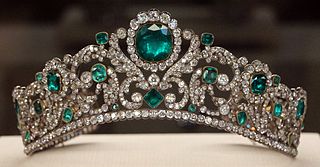
A tiara is a jeweled head ornament dating back to ancient times. In the late 18th century, the tiara came into fashion in Europe as a prestigious piece of jewelry to be worn by women at formal occasions. The basic shape of the modern tiara is a semi-circle, usually made of silver, gold or platinum and richly decorated with precious stones, pearls or cameos.

The French Crown Jewels and Regalia comprise the crowns, orb, sceptres, diadems and jewels that were symbols of Royal or Imperial power between 752 and 1870. These were worn by many Kings and Queens of France as well as Emperor Napoleon. The set was finally broken up, with most of it sold off in 1885 by the Third Republic. The surviving French Crown Jewels, principally a set of historic crowns, diadems and parures, are mainly on display in the Galerie d'Apollon of the Louvre, France's premier museum and former royal palace, together with the Regent Diamond, the Sancy Diamond and the 105-carat (21.0 g) Côte-de-Bretagne red spinel, carved into the form of a dragon. In addition, some gemstones and jewels are on display in the Treasury vault of the Mineralogy gallery in the National Museum of Natural History.

The Iranian National Jewels, originally the Iranian Crown Jewels, include elaborate crowns, thirty tiaras, and numerous aigrettes, a dozen bejeweled swords and shields, a number of unset precious gems, numerous plates and other dining services cast in precious metals and encrusted with gems, and several other more unusual items collected or worn by the Persian monarchs from the 16th century and on. The collection is housed at the Treasury of National Jewels, situated inside the Central Bank of Iran on Tehran's Ferdowsi Street.

Harry Winston was an American jeweler. He donated the Hope Diamond to the Smithsonian Institution in 1958 after owning it for a decade. He also traded the Portuguese Diamond to the Smithsonian in 1963 in exchange for 3,800 carats of small diamonds.
The Ruspoli Sapphire, also known as the Wooden Spoon Seller's Sapphire, is a 136.9 carat blue sapphire that has historically been confused with Grand Sapphire of Louis XIV. Recent research has shown that not only are these two separate gems, but also that the story of once being owned by the Ruspoli family and having been acquired from a wooden spoon seller in Bengal are both apocryphal tales with no basis. The origins of this confusion stem from a book published in 1858 by Charles Barbot, who confused the Ruspoli Sapphire with the Grand Sapphire of Louis XIV.
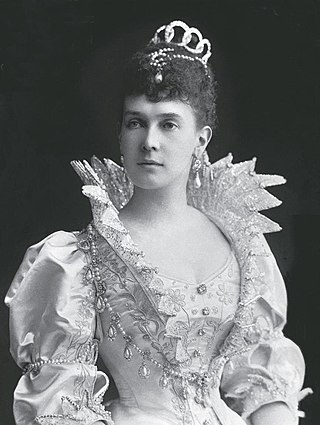
Duchess Marie of Mecklenburg-Schwerin, later Grand Duchess Maria Pavlovna, Grand Duchess Vladimir "Miechen" of Russia, also known as Maria Pavlovna the Elder, was the eldest daughter of Grand Duke Friedrich Franz II of Mecklenburg-Schwerin by his first wife, Princess Augusta Reuss of Köstritz. A prominent hostess in Saint Petersburg following her marriage in 1874 to the Grand Duke Vladimir Alexandrovich of Russia, she was known by many as the "grandest of the grand duchesses".
The unnamed Kashmir sapphire is a 22.66 carat gem. It is known for its former owner, railroad executive James J. Hill, who purchased it in 1886 for his wife as part of a diamond- and sapphire-adorned necklace. It was eventually split off and given to one of their children. It was later donated to the Minnesota Historical Society, who sold it at auction at Christie's for $3,064,000, ahead of expectations. It is currently the world's most valuable known sapphire.
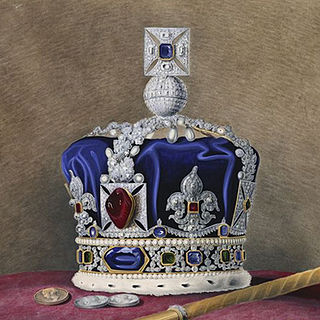
The Stuart Sapphire is a blue sapphire that forms part of the British Crown Jewels. It weighs 104 carats and is believed to have originated from Asia, potentially present-day Afghanistan, Sri Lanka, Myanmar or Kashmir.

Queen Elizabeth II owned a historic collection of jewels – some as monarch and others as a private individual. They are separate from the gems and jewels of the Royal Collection, and from the coronation and state regalia that make up the Crown Jewels.
The Briolette of India is a colorless diamond that was found in India. It is cut in a briolette shape, and is a D-coloured (colourless) type IIa diamond. Its history was thought to date from the 12th century, when it was first acquired by Eleanor of Aquitaine, the Queen consort of King Louis VII of France between 1137 and 1152. This makes the Briolette of India the oldest diamond on record in the world, even older than the famous Koh-i-Noor.

The Bismarck Sapphire Necklace is a sapphire necklace designed by Cartier, Inc. in 1935. As of 2010, the necklace is on display between the Hall Sapphire and Diamond Necklace and the Logan Sapphire in the Janet Annenberg Hooker Hall of Geology, Gems, and Minerals at the Smithsonian Institution's National Museum of Natural History in Washington D.C., United States. It is named after Countess Mona von Bismarck, who donated the piece to the Smithsonian in 1967. The sapphire itself was mined in Burma, and was purchased by the Countess in Sri Lanka in 1926 during her honeymoon with Harrison Williams.
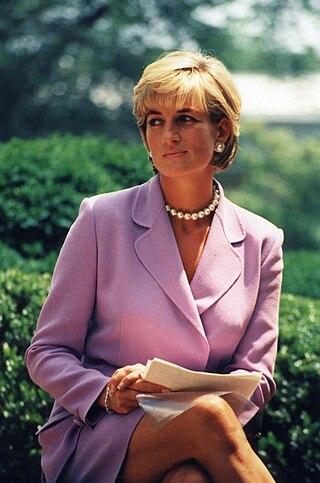
Diana, Princess of Wales, owned a collection of jewels both as a member of the British royal family and as a private individual. These were separate from the coronation and state regalia of the crown jewels. Most of her jewels were either presents from foreign royalty, on loan from Queen Elizabeth II, wedding presents, purchased by Diana herself, or heirlooms belonging to the Spencer family.
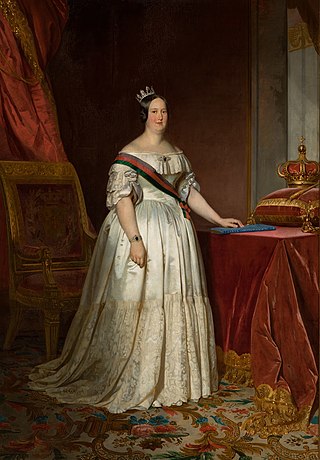
The Tiara of Maria II is a jewelled, ornamental crown made for Queen Maria II of Portugal in the 1830s-40s, set in sapphires and diamonds. It is the oldest extant tiara that can be linked to a Portuguese sovereign.
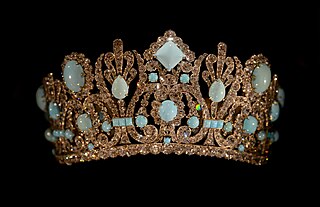
The Marie Louise Diadem is a diamond and turquoise diadem on permanent display at the National Museum of Natural History in Washington D.C.. It is named for Marie Louise of Austria, the wife of Emperor Napoleon of France.
The joyas de pasar are a historic collection of jewels, privately owned by the head of the Spanish royal family, to be worn by the Queen of Spain on solemn occasions. The initial jewellery set was gathered by Queen Victoria Eugenie, wife of King Alfonso XIII, and are transmitted to the next generation following the instructions that she left in her will. They are separate from the Regalia of Spain which is owned by the Spanish State.














